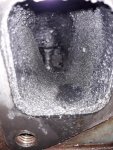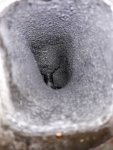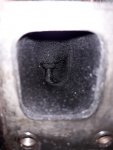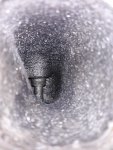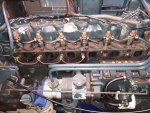Has anyone seen this gunk inside intake ports before and knows the cause?
[images below]
I was surprised when I pulled the intake manifold of my M4500 model S2600 engine (82mm stroke precombustion chamber, 6 cylinder, naturally aspirated) to find soft thick oily deposits (not hard carbon) have built up in all intake ports, from valve to about 2 to 2-1/2" upsteam of the valve into the manifold. The engine has done 5000 hours, I doubt that it has had the head or manifold off previously. The trunking from the air cleaner to the manifold was clean, no traces of dust, so I'm pretty sure its oil not dust build-up.
Possible causes that I've found through internet trawling:
1. At low engine speed/power, some boffins say that exhaust gases and unburnt fuel can get into intake port upstream of the intake valve head during intake and exhause valve overlap and and leave deposits upstream of the inlet valve. Personally I've never heard of this being a problem before. I don't think the engine has been run consistently at higher power levels in recent years (I've had it about 18 months) and find that it develops enough power for what I need at about 1200 rpm (max governed is 2800). So I can't discount that idea, but maybe you can.
2. Oil leaking past valve stem seal and down the valve guide. However, there's no sign of blue exhaust smoke, nor oil consumption. But I can think of 2 situations that might promote this problem:
(a) The tractor does get operated at some fairly extreme angles so it's possible that oil does build up from time to time on top of the cylinder head, to the valve side of the cylinder head, or at front or rear of cylinder head
(example: doing a lot of 3PH blade work on a steep slope, going across it) - but I don't know whether this is enough to cause oil to build up in the space between the head and the sides of the rocker cover, and flood the intake valve seals.
(b) Valve stem seals have deteriorated with age - the tractor is about 40 years old.
I'd love to hear from anyone who has encountered this before and identified the cause, or who can identify most likely potential causes.
If the cause is most likley failed valve stem seals, what's the best process for replacing them without having to pull the head off? And process for cleaning out the intake port passages without removing the head.
Thanks for your help.
[images below]
I was surprised when I pulled the intake manifold of my M4500 model S2600 engine (82mm stroke precombustion chamber, 6 cylinder, naturally aspirated) to find soft thick oily deposits (not hard carbon) have built up in all intake ports, from valve to about 2 to 2-1/2" upsteam of the valve into the manifold. The engine has done 5000 hours, I doubt that it has had the head or manifold off previously. The trunking from the air cleaner to the manifold was clean, no traces of dust, so I'm pretty sure its oil not dust build-up.
Possible causes that I've found through internet trawling:
1. At low engine speed/power, some boffins say that exhaust gases and unburnt fuel can get into intake port upstream of the intake valve head during intake and exhause valve overlap and and leave deposits upstream of the inlet valve. Personally I've never heard of this being a problem before. I don't think the engine has been run consistently at higher power levels in recent years (I've had it about 18 months) and find that it develops enough power for what I need at about 1200 rpm (max governed is 2800). So I can't discount that idea, but maybe you can.
2. Oil leaking past valve stem seal and down the valve guide. However, there's no sign of blue exhaust smoke, nor oil consumption. But I can think of 2 situations that might promote this problem:
(a) The tractor does get operated at some fairly extreme angles so it's possible that oil does build up from time to time on top of the cylinder head, to the valve side of the cylinder head, or at front or rear of cylinder head
(example: doing a lot of 3PH blade work on a steep slope, going across it) - but I don't know whether this is enough to cause oil to build up in the space between the head and the sides of the rocker cover, and flood the intake valve seals.
(b) Valve stem seals have deteriorated with age - the tractor is about 40 years old.
I'd love to hear from anyone who has encountered this before and identified the cause, or who can identify most likely potential causes.
If the cause is most likley failed valve stem seals, what's the best process for replacing them without having to pull the head off? And process for cleaning out the intake port passages without removing the head.
Thanks for your help.
Attachments
-
83.6 KB Views: 264
-
148.3 KB Views: 206
-
106.8 KB Views: 288
-
173.2 KB Views: 193
-
141.3 KB Views: 213
Last edited:


